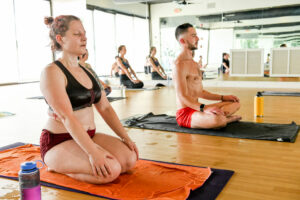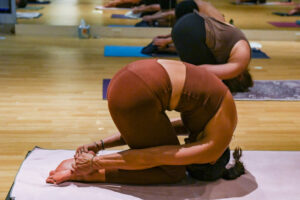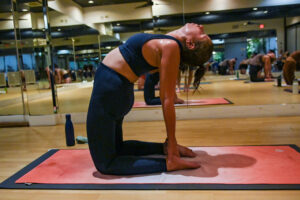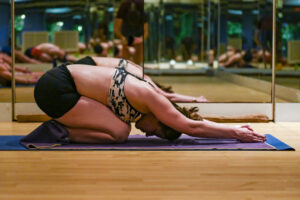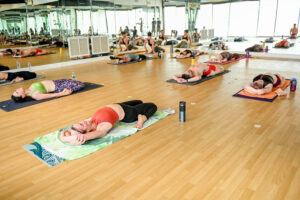YogaSol > yoga science >
Hot yoga kapalabhati breathing can get you ready for the day.
Breathing is all the rage these days. Everyone’s doing it. 😉 And what’s more, everyone’s talking about it. I feel myself getting a little out of breath just thinking about it.
And because there are so many studies happening on breath work, I’ve started noticing my breathing and how it makes me feel more and more often.
Try something with me. Breath in for 4 counts, hold for 4 counts, and exhale for 4 counts. Repeat that for 5 breaths. How are you feeling?
Me, I just practiced that myself, and my shoulders moved away from my ears. I feel more calm and relaxed. Less uptight.
Now try something else with me. Think of the song, “Stayin’ Alive.” Clap or snap that beat. Yes, you can even sing a few bars. “Ah, ah, ah, ah…”
On your clap or snap, move only your navel toward your spine and force the air out of your lungs with your mouth slightly open. To the beat of the song. Do this for 60 seconds.
Now how do you feel? Not relaxed, that’s for sure. But it does bring some energy and focus, right?
Different types of breath work do different things inside our bodies. And with just two exercises, you can see that focusing on your breath and changing your breathing can change everything. Your mood. Your energy. All of that changes in minutes. It’s one of the easiest ways to begin controlling how you feel and react to the world around you.
Hot Yoga and Breathing
In our hot yoga 26 & 2 classes, we begin and end with the breath. And in between, all poses are connected with the breath. The breath work we do in our hot yoga classes changes our mood, energy, and focus, moment by moment.
I don’t know about you, but by the end of an OG hot 26 & 2 practice, I can feel spent. I mean, my motto is leave it all on the mat. So, by the end of class, I’ve used up my energy tank.
And yet, when I walk away, I leave feeling more energized than when I walked in. How can that be?
I think there’s a lot happening in the final pose – kapalabhati breathing or the Blowing Out Pose. Yes, it’s a breathing exercise. So, how does that refill my energy tank?
Let’s talk through the affect this exercise has on the body.
Hot Yoga 26 & 2 Breathing Exercises
We begin each hot yoga 26 & 2 class with standing pranayama breathing to bring focus to our practice. Pranayama breathing connects our minds with our bodies and prepares us to concentrate our energy on each new posture. Our first breathing exercise provides us with many other mental and physical health benefits as well.
Read more about standing pranayama breathing, pose #1 in our 26 & 2 practice, in this article here.
The first posture is a slow breath in, matched by a slow breath out.
By contrast, the final posture of the practice requires quick, shallow, explosive breaths out. I’ve found my body longing for deep gulps of oxygen at this point of my practice. We’re in a hot room, after all. We’ve practiced for over an hour.
Instead, I fight my urge for oxygen and follow the increasing rhythmic instruction to push the air quickly from my lungs with my diaphragm.
And this increasing rhythm creates a cyclic hyperventilation that continues for a couple of minutes. It’s voluntary, controlled, and lasts just long enough to increase adrenaline and all its reenergizing benefits.
What is Kapalabhati?
In Hot yoga 26 & 2, Kapalabhati is the final breathing exercise of the practice. “Kapala” means “skull” and “Bhati” means “to shine.” This exercise is meant to make your skull shine by clearing out the head and bringing a rush of oxygen to the brain.
What makes this particular breathing exercise so different from others we practice in yoga is the focus on the exhale vs the inhale. The inhale of breath is passive and happens automatically between the exhales.
This posture mimics our “Stayin’ Alive” exercise we tried at the beginning of this article but with better form and function.
So, how do we perform the Kapalabhati breathing exercise correctly?
At the end of our hot yoga 26 & 2 classes, we ask everyone to sit on their legs with their knees touching and their feet underneath them. If you have knee problems we offer an alternative of sitting in the lotus position with your legs crossed in front of you.
Resting your hands on your knees, you want to keep your chest up with your shoulders back. We suggest you lock the elbows to help you keep your spine straight.
If you’ve heard of Kapalabhati breathing before, you may have had instruction to breath out through your nose. However, in the Hot 26 & 2 classes, we exhales through a small opening in our mouths. It makes a kind of shush-ing sound.
You begin by filling your lungs with a deep inhale. Then you push the air out of your mouth by forcefully contracting your abdomen, rapidly pulling your navel toward your spine. Concentrate on the exhale, and the inhale will automatically happen between exhales.
During the breathing exercise, your belly is the only thing you should be moving as you contract your abdomen and force the air out of your mouth. Your instructor will clap to the beat of the exhale. So, it’s easy to follow their lead.
The first round of exhales is slower than the second. And even though it’s the slower of the two rounds, it doesn’t mean it’s slow. The exhales are short, shallow, and forceful.
Each round lasts for 60 breaths.
Beginner mistakes
Many beginners forget to lock their elbows. And because this is the final posture, and they’re tired, they slouch their shoulders. When they breathe they tend to bounce their whole upper body.
While the form here is meant to conserve energy, they actually end up expending more energy than they need to.
The quick fix is locking the elbows to keep everything lifted and aligned.
Benefits of cyclic hyperventilation through Kapalabhati
Hyperventilation gets a bad rap. That’s because it’s usually your body’s response to things going a bit haywire. And it’s your body’s way of bringing things back to homeostasis. However, recently, more and more research shows that voluntary and controlled hyperventilation can offer many health benefits.
What happens during controlled hyperventilation?
When you voluntarily practice controlled hyperventilation, you’re pushing out more carbon dioxide than you’re taking in. The thought of kapalabhati clearing the head is a result of releasing extra carbon dioxide you may have built up during the rigor of your yoga class.
Voluntary hyperventilation activates the sympathetic nervous system. This causes the release of adrenaline in the body, which gives us a few benefits after we practice.
Enhances Your Immune System – Combatting Infection
In research by PNAS, they studied meditation alone vs voluntary, controlled hyperventilation exercises. The researchers found that the group practicing controlled hyperventilation had an increase in anti-inflammatory workers (cytokines) in the body when exposed to disease. And levels of pro-inflammatory workers were lower. After introducing disease into the body, their flu-like symptoms were also lower. This is work of the adrenaline in the immune system. Adrenaline gets your body ready to fight infection and disease.
Heats the Body
Increased adrenaline also increases your metabolic temperature. We’re already increasing our body’s core temperature just by practicing in the hot room. And that actually increases our metabolism.
For more health benefits of heat exposure in the hot room, read this article.
The adrenaline release we create with controlled hyperventilation at the end of our practice supercharges our metabolism.
Increased Limb Blood Flow
A study published in PubMed also showed an increase in blood flow to our limbs as adrenaline increases in our bodies. That’s because adrenaline helps you prepare to fight or flee. Sending more blood to your limbs keeps your body ready to take action. And that’s another reason you can feel more ready to get moving and get things done after a hot yoga 26 & 2 class.
Amplifies Focus
Because adrenaline is meant to help us take action, it also helps our mind zero in on the few, very important items that require our focus. Think of it in terms of a dangerous situation. We need the ability to focus only on what will keep us alive. So, when we voluntarily increase adrenaline in our system, we can zero-in on a few very important things that we need to accomplish.
Increases Energy
There’s no question about it. Adrenaline and kapalabhati breathing gives us a boost of energy. Again, this is all related to our fight or flight system. If you’re in danger, you have to have enough energy to take action. It’s well proven that adrenaline increases energy when it’s produced in the body.
Boosts Learning Ability
One of the best parts of controlled hyperventilation is the ability to solidify learning experiences. When blood levels of adrenaline and epinephrine are high, physical and mental performance goes up. This is shown in research again and again. We do our best when we are revved up and slightly stressed.
And the affects of adrenaline and epinephrine perform best for memory consolidation, immediately after learning. That’s one reason this Kalapabhati exercise works so well at the very end of class. We’re consolidating the learning and your body’s muscle memory from class with our final exercise.
What about the bad affects of adrenaline?
All of this sounds great, except, isn’t adrenaline bad for you? The truth is, adrenaline is neither bad nor good for you. It’s like any other metabolic substance. Our body needs it. But we don’t want too much or too little of it.
We end our hot yoga 26 & 2 classes with a kapalabhati breathing exercise that consists of two rounds of 60 breaths. That means we’re giving your body a goldilocks portion of the energy boost you need to face whatever is next in your day.
Want to learn how to breathe like a hot yoga trainer? Join us in our next posture class specifically focused on breathing, held Tuesday, November 15th, at 2 p.m.
 -ing our NEW! Community Classes!
-ing our NEW! Community Classes!
